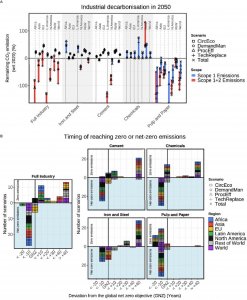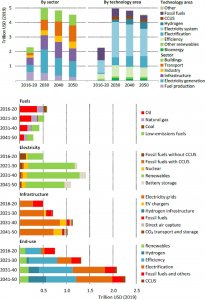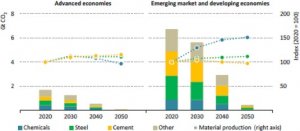
Researchers including KU’s Dr. Steve Griffiths propose six bold steps for accelerating progress on achieving net-zero industrial carbon emissions by 2050. Achieving a net-zero industry is a crucial goal for mitigating climate change and reducing greenhouse gas emissions.
The global industrial sector accounted for 38 percent of total final energy use in 2020. Industry is also the sector with the fastest growing carbon dioxide emissions and is the single largest source of global greenhouse emissions — more than one third — when electricity consumption and heat generation are considered.
Industry has long been sheltered from strong energy and climate policies over concerns about job losses, national competitiveness, and cross-border carbon leakage. But researchers say the rapid and deep decarbonization of global industry is key to reaching climate policy targets. Dr. Steve Griffiths, KU’s Senior Vice President for Research and Development and Professor of Practice, together with Dr. Benjamin Sovacool, University of Sussex and Boston University, Dr. Morgan Bazilian, Colorado School of Mines, and Dr. Jinsoo Kim, Hanyang University, have recognized the challenge and proposed six “bold steps” for accelerating progress on achieving net-zero industrial emissions by 2050. These steps are (1) quintupling financing, (2) expediting technology transfer, (3) investing in human resources, (4) setting binding targets, (5) steering social acceptance and (6) enacting a new global treaty and shaping climate clubs.
Their work was published in Energy Research & Social Science, a top 1% journal in the energy field.
“In a very small number of sectors, such as electricity or buildings, pathways to net zero may be well understood and even cost-effective, but these are the exceptions, not the norm,” Dr. Griffiths says, highlighting industry as “particularly difficult.”
“There are effective, transformative and promising innovations for industrial decarbonization, but applying these globally is difficult because not all countries are in the position to rapidly adopt them.
Said innovations include the use of direct reduced iron (based on low- and zero-carbon hydrogen) in the steel industry and the pursuit of a cluster approach to decarbonization. The latter allows for geographically consolidated supply and demand balancing to achieve scale up of cross-cutting technologies such as carbon capture and low-carbon hydrogen. Measures to mitigate other potent greenhouse gases, such as methane, nitrous oxide, and fluorinated gases, are also underway and critical achieving net-zero for all greenhouse gases.

Fig. 1. Overview of net and direct carbon emissions from the global industrial sector in 2050.
But financial barriers, insufficient infrastructure, lack of required labor force skills, lock-in effects, and political economy considerations are hindering efforts to implement transformative innovations globally and require solutions tailored to context, say the researchers.
“Even though we call our required actions ‘steps’, they are not sequential and actually should be pursued simultaneously, starting immediately,” Dr. Griffiths says. “Undertaking these actions now would transform the largest single source of total final energy demand, and the fastest growing segment of greenhouse gas emissions from a nagging problem into a compelling solution, a leverage point that deeply embeds net-zero infrastructure and practice into our climate future.”
Although the team members insist their steps are not sequential, they recognize that the net-zero challenge begins — though does not end — with money.
Scaling up international financial support for industrial decarbonization, particularly in developing countries, is critical. The researchers say annual spending on industrial decarbonization interventions needs to increase more than seven-fold by 2030 relative to the level of investments made between 2016 and 2021. Some projections suggest as much as a ten-fold increase is needed if net-zero ambitions are to be achieved.

Fig. 2. Projections of annual average capital investment in net-zero energy infrastructure by sector and technology area.
“Various direct transfer mechanisms exist to support countries financially, such as up-front grants and funding during operation, and these are complemented by mechanisms to facilitate access to financing, such as risk coverage, loans, and equity investments,” Dr. Griffiths says.
African nations, for instance, need to invest about US $16 billion to curtail oil refinery emissions sufficiently to achieve the continent’s climate change ambitions and demand for energy in the continent grows. Hence, bolstering the deployment of decarbonization options via new modes of finance is essential for this and many other decarbonization needs across the developing world.
“Financial mechanisms could focus on facilitating adoption of cross-cutting solutions like electrification, material efficiency and the use of carbon capture and low-carbon hydrogen to decarbonize the most carbon-intensive industries, which include iron and steel and chemicals,” Dr. Griffiths adds. Carbon capture and hydrogen are particularly important for sectors with significant embodied feedstock emissions, like chemicals and refined oil products.
Direct financial support in the form of loans and credit guarantees, which have steered the development of rail, waterways, and other infrastructure to facilitate decarbonization of long-haul freight transport in Brazil, serve as an example of the types of financial mechanisms relevant achieving net-zero industries broadly..
Ensuring adequate financing is necessary, but “by no means sufficient” with the research team also highlighting the need to expedite technology transfer to developing countries, prioritizing the Global South, since this is where industry energy demand, and related carbon emissions, are expected to grow most strongly.
Technology transfer mechanisms developed and leveraged in response to the COVID-19 pandemic may come in handy here. The research team suggests they can be adopted to help overcome intellectual property barriers related to carbon capture and storage technologies, fuel cells, efficiency upgrades to industrial processes, and other such decarbonization levers.

Fig. 3. Global carbon emissions from industry, 2020-2050
Additionally, a response to the “huge skills shortage” looming is needed to prevent it hindering the attainment of net-zero industry. Skilled welders, civil engineers, and machinists are in short supply in the short term, according to the researchers, but the long-term workforce needs people with the digital skills required for the increasing levels of industrial automation. Investing in human resources and capacity is critical now for a net-zero future.
Industry collaborations should also be prioritized:
“Some of the most pressing and urgent climate change and net-zero challenges necessitate transboundary cooperation,” Dr. Griffiths says. “Traditional climate governance systems centered on nation-states and intergovernmental organizations are proving inadequate. A new institution, or a far-reaching reform of existing institutions, to provide international rule-setting and globally accepted certifications and standards for low and zero-carbon industrial products is likely needed. More specifically, we need a mechanism for achieving a rapid and coordinated sectoral approach to mobilizing sufficient resources, and avoiding unfair competition and carbon leakage as we pursue net-zero industry.”
Beyond the economic, political and intellectual challenges, attention is warranted on the people at the social heart of industrial change. Social acceptance and public opinion are clear core elements of successful transitions, net-zero or otherwise, but especially in an industrial context, according to the researchers. In communities where industrial transition can have significant socio-economic impacts, policies need public buy-in.
“Global decarbonization of industry will not occur without concerted action from governments, private sector entities, and civil society and members of the public,” Dr. Griffiths says. “Successful decarbonization will require more money, jobs, technology transfer, and coordination of sub-national and non-traditional actors, as well as shaping patterns of social acceptance and implementing new modes of global climate governance.”
Jade Sterling
Science Writer
22 May 2023






